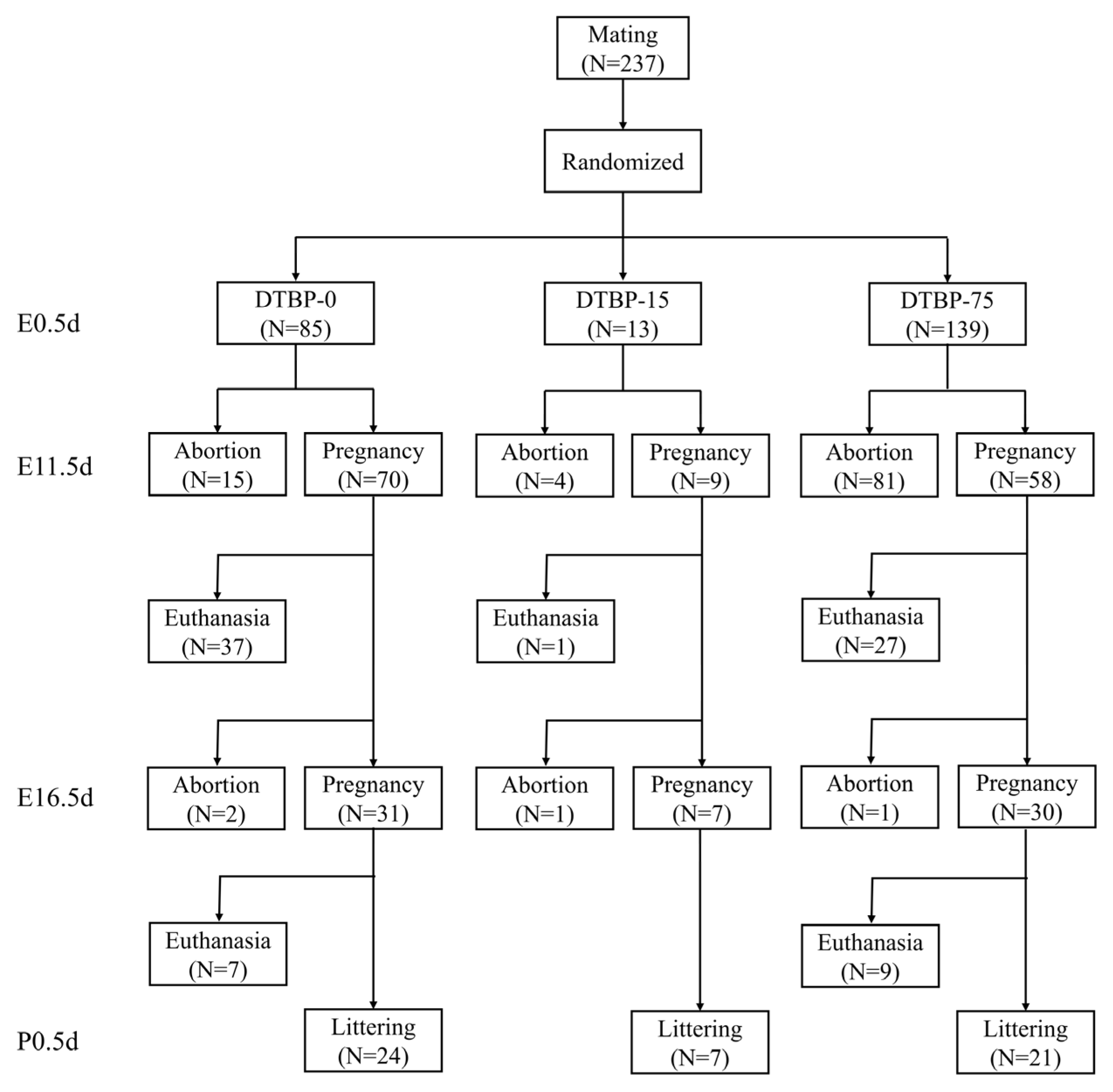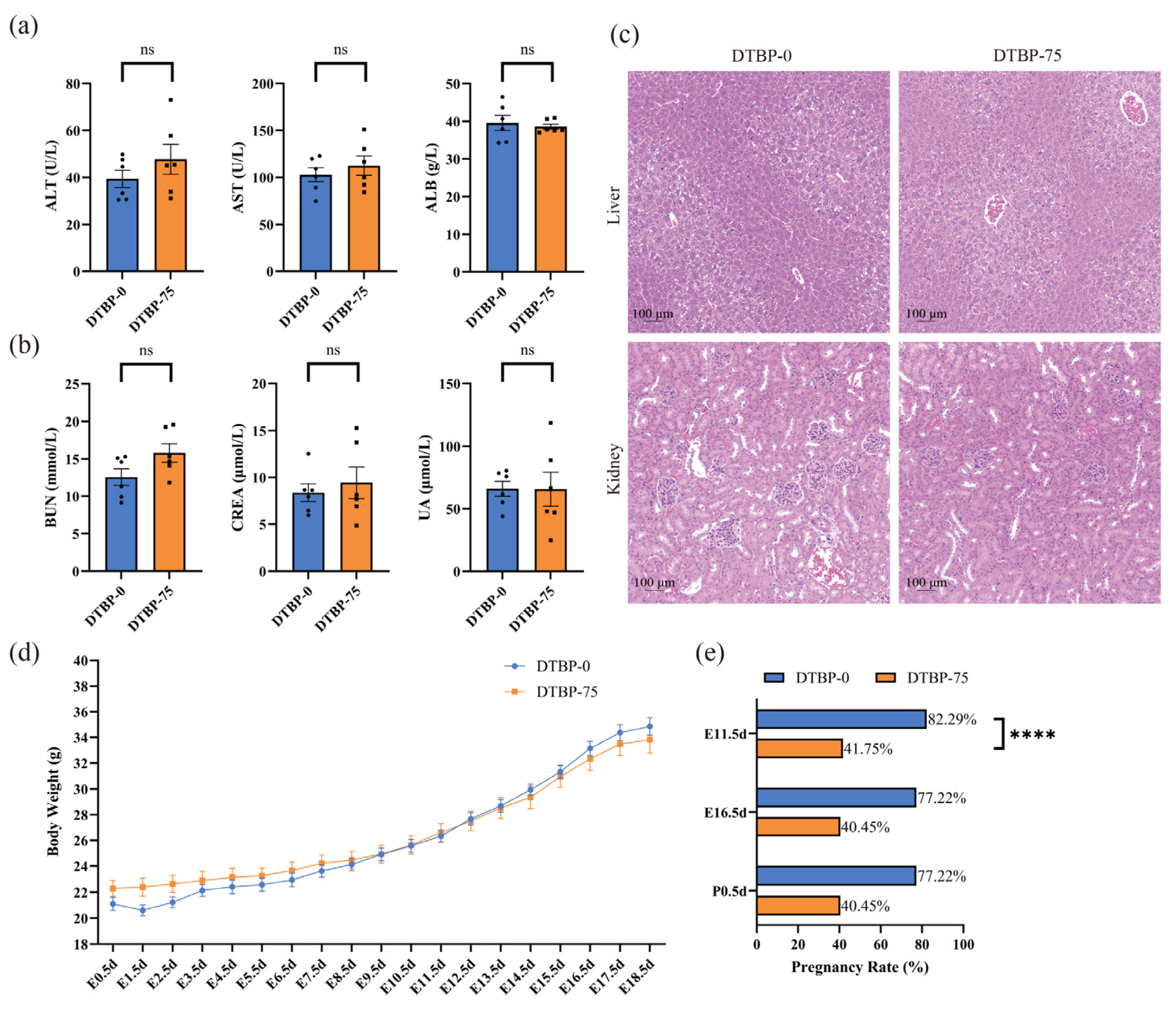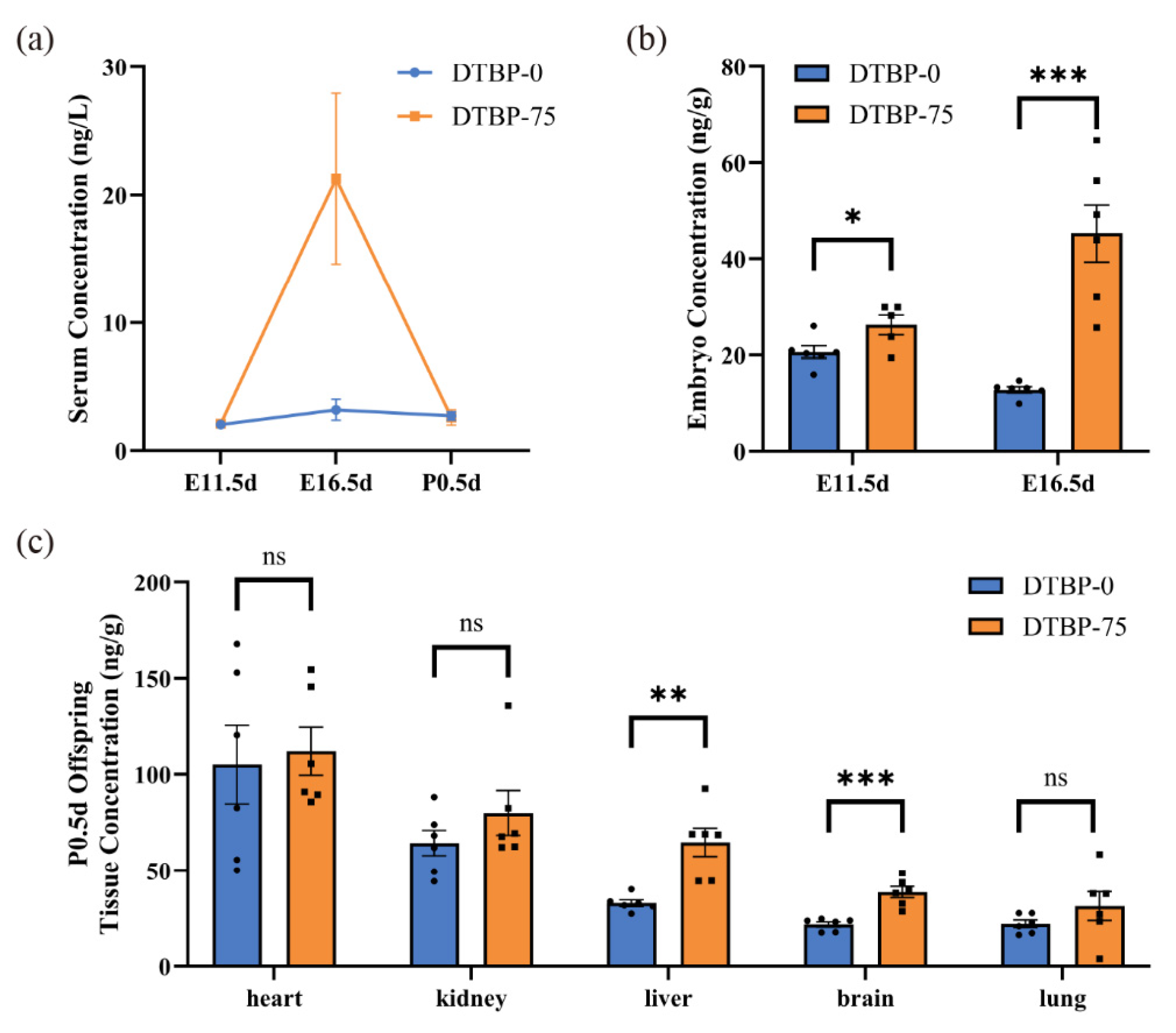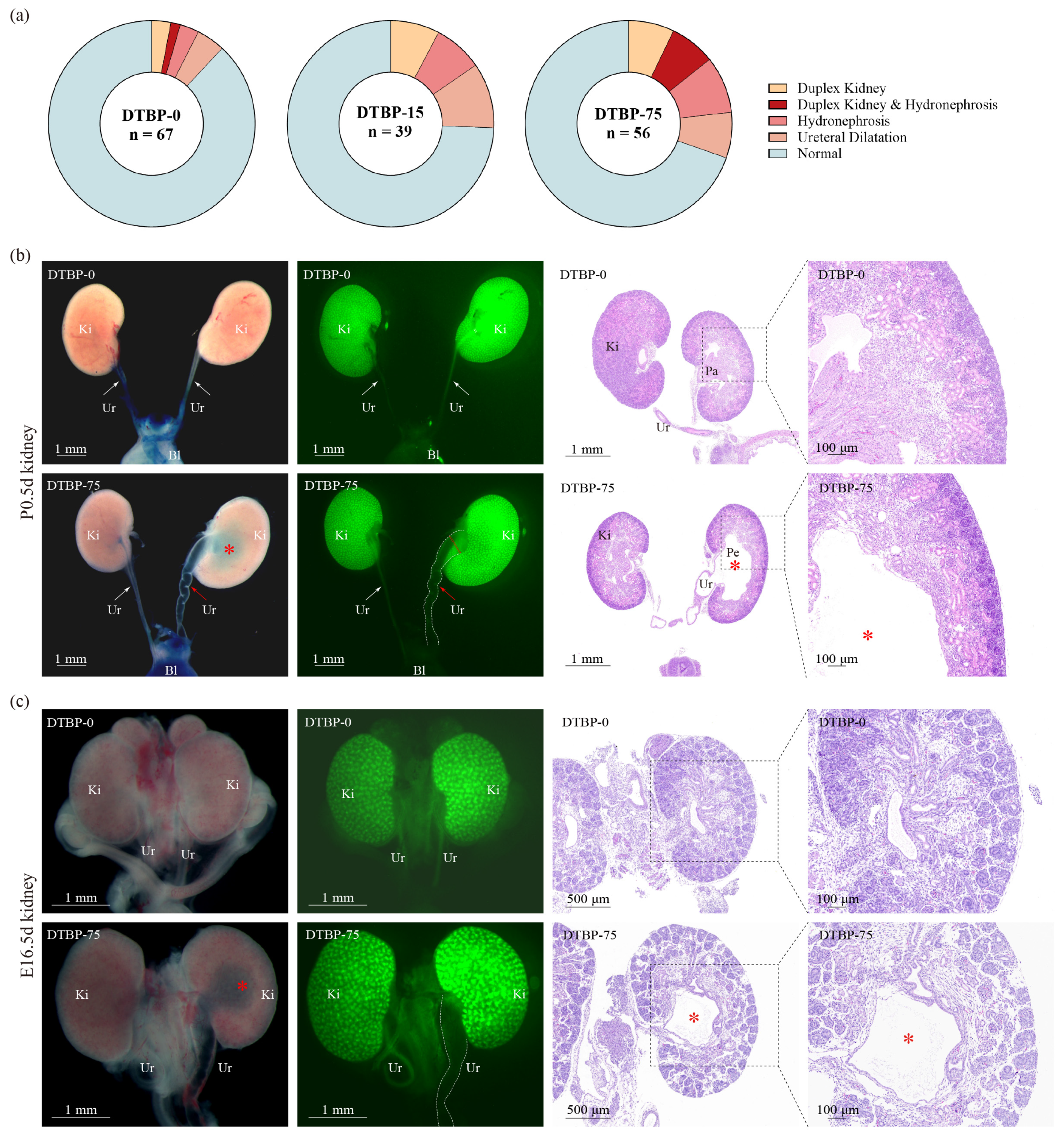Maternal Exposure to 2,4-Di-tert-butylphenol During Pregnancy in a Mouse Model Leads to Abnormal Development of the Urinary System in Offspring
Abstract
1. Introduction
2. Materials and Methods
2.1. Chemicals
2.2. Animals and Experimental Schemes
2.3. Measurement of Liver and Kidney Function
2.4. Sample Collection
2.5. Sample Preparation
2.6. Liquid Chromatography–Tandem Mass Spectrometry (LC-MS) Analysis
2.7. Hematoxylin-Eosin (H&E) Staining
2.8. Alcian Blue and Alizarin Red Staining
2.9. CAKUT Assessment and Vesicoureteral Reflux (VUR) Test
2.10. Statistical Analysis
3. Results
3.1. Exposure to 2,4-DTBP During Pregnancy Is Associated with the Risk of Early Pregnancy Loss (EPL)
3.2. The Effects of Intrauterine Exposure to 2,4-DTBP on the Number and Size of Offspring
3.3. Bioaccumulation and Maternal–Fetal Transfer of 2,4-DTBP
3.4. Intrauterine Exposure to 2,4-DTBP Increased the Risk of CAKUT in Offspring
4. Discussion
5. Conclusions
Supplementary Materials
Author Contributions
Funding
Institutional Review Board Statement
Informed Consent Statement
Data Availability Statement
Acknowledgments
Conflicts of Interest
Abbreviations
| CAKUT | congenital anomalies of the kidney and urinary tract |
| EDCs | endocrine-disrupting chemicals |
| 2,4-DTBP | 2,4-Di-tert-butylphenol |
| RR | relative risk |
| SPA | synthetic phenolic antioxidant |
| NOAEL | No-Observed-Adverse-Effect Level |
| DMSO | dimethyl sulfoxide |
| PEG 300 | polyethylene glycol 300 |
| Tween 80 | polysorbate 80 |
| E0.5d | embryonic 0.5 day |
| P0.5d | postnatal 0.5 day |
| LC-MS | liquid chromatography–tandem mass spectrometry |
| MRM | multiple reaction monitoring |
| ESI | electrospray ionization |
| CE | collision energy |
| CXP | collision cell exit potential |
| H&E | hematoxylin–eosin |
| VUR | vesicoureteral reflux |
| GEE | generalized estimating equations |
| LMM | linear mixed-effects model |
| SE | standard error |
| CI | confidence interval |
| ns | non-significant |
| EPL | early pregnancy loss |
| ALT | alanine transaminase |
| AST | aspartate aminotransferase |
| ALB | albumin |
| BUN | blood urea nitrogen |
| CREA | creatinine |
| UA | uric acid |
| MQL | method quantification limit |
| POPs | persistent organic pollutants |
| HCB | hexachlorobenzene |
| p, p′-DDE | dichlorodiphenyldichloroethylene |
| BHT | 2,6-di-tert-butyl-hydroxytoluene |
| RXRα | retinoid X receptor α |
| RA | retinoic acid |
References
- Dugoff, L. Ultrasound Diagnosis of Structural Abnormalities in the First Trimester. Prenat. Diagn. 2002, 4, 316–320. [Google Scholar] [CrossRef] [PubMed]
- Kolvenbach, C.M.; Shril, S.; Hildebrandt, F. The Genetics and Pathogenesis of CAKUT. Nat. Rev. Nephrol. 2023, 11, 709–720. [Google Scholar] [CrossRef] [PubMed]
- Dart, A.B.; Ruth, C.A.; Sellers, E.A.; Au, W.; Dean, H.J. Maternal Diabetes Mellitus and Congenital Anomalies of the Kidney and Urinary Tract (CAKUT) in the Child. Am. J. Kidney Dis. 2015, 5, 684–691. [Google Scholar] [CrossRef] [PubMed]
- Martinovic, J.; Benachi, A.; Laurent, N.; Daikha-Dahmane, F.; Gubler, M.C. Fetal Toxic Effects and Angiotensin-II-Receptor Antagonists. Lancet 2001, 9277, 241–242. [Google Scholar] [CrossRef]
- Yu, M.; Ju, H.; Ye, N.; Chen, J.; Sun, L.; Wu, X.; Xu, H.; Shen, Q. Vitamin A Deficiency Disturbs Ret Expression and Induces Urinary Tract Developmental Abnormalities in Mice. Am. J. Nephrol. 2024, 1–11. [Google Scholar] [CrossRef]
- Garlantézec, R.; Monfort, C.; Rouget, F.; Cordier, S. Maternal Occupational Exposure to Solvents and Congenital Malformations: A Prospective Study in the General Population. Occup. Environ. Med. 2009, 7, 456–463. [Google Scholar] [CrossRef]
- Spinder, N.; Bergman, J.E.H.; van Tongeren, M.; Boezen, H.M.; Kromhout, H.; de Walle, H.E.K. Maternal Occupational Exposure to Endocrine-Disrupting Chemicals and Urogenital Anomalies in the Offspring. Hum. Reprod. 2021, 1, 142–151. [Google Scholar] [CrossRef]
- Liu, R.; Mabury, S.A. Synthetic Phenolic Antioxidants in Personal Care Products in Toronto, Canada: Occurrence, Human Exposure, and Discharge via Greywater. Environ. Sci. Technol. 2019, 22, 13440–13448. [Google Scholar] [CrossRef]
- Available online: https://hpvchemicals.oecd.org/UI/AllChemicals.aspx (accessed on 17 November 2024).
- Xie, W.; Zhao, J.; Zhang, Q.; Ye, C.; Zheng, G.; Shan, Q.; Li, L.; Shao, X. Occurrence, Distribution and Bioaccumulation of Alkylphenols in the Pearl River Networks, South China. Ecol. Indic. 2020, 110, 105847. [Google Scholar] [CrossRef]
- Han, B.; Shang, Y.; Wang, H.; Shen, Y.; Li, R.; Wang, M.; Zhuang, Z.; Wang, Z.; Fang, M.; Jing, T. Prevalence of Synthetic Phenolic Antioxidants in Food Contact Materials from China and Their Implications for Human Dietary Exposure through Take-Away Food. J. Hazard. Mater. 2024, 473, 134599. [Google Scholar] [CrossRef]
- Liu, R.; Mabury, S.A. Synthetic Phenolic Antioxidants and Transformation Products in Human Sera from United States Donors. Environ. Sci. Technol. Lett. 2018, 7, 419–423. [Google Scholar] [CrossRef]
- Liu, R.; Mabury, S.A. Unexpectedly High Concentrations of 2,4-Di-Tert-Butylphenol in Human Urine. Environ. Pollut. 2019, 252 Pt B, 1423–1428. [Google Scholar] [CrossRef]
- Zhang, Y.; Du, B.; Ge, J.; Liu, L.; Zhu, M.; Li, J.; Zeng, L. Co-Occurrence of and Infant Exposure to Multiple Common and Unusual Phenolic Antioxidants in Human Breast Milk. Environ. Sci. Technol. Lett. 2020, 3, 206–212. [Google Scholar] [CrossRef]
- Du, B.; Zhang, Y.; Lam, J.C.W.; Pan, S.; Huang, Y.; Chen, B.; Lan, S.; Li, J.; Luo, D.; Zeng, L. Prevalence, Biotransformation, and Maternal Transfer of Synthetic Phenolic Antioxidants in Pregnant Women from South China. Environ. Sci. Technol. 2019, 23, 13959–13969. [Google Scholar] [CrossRef] [PubMed]
- Halim, N.A.; Razak, S.B.A.; Simbak, N.; Seng, C.T. 2,4-Di-Tert-Butylphenol-Induced Leaf Physiological and Ultrastructural Changes in Chloroplasts of Weedy Plants. S. Afr. J. Bot. 2017, 112, 89–94. [Google Scholar] [CrossRef]
- Qi, J.; Song, Y.; Liang, J.; Bai, Y.; Hu, C.; Liu, H.; Qu, J. Growth Inhibition of Microcystis aeruginosa by Sand-Filter Prevalent Manganese-Oxidizing Bacterium. Sep. Purif. Technol. 2021, 256, 117808. [Google Scholar] [CrossRef]
- Zhang, J.; Liang, X.; Chen, H.; Guo, W.; Martyniuk, C.J. Exposure to Environmental Levels of 2,4-Di-Tert-Butylphenol Affects Digestive Glands and Induces Inflammation in Asian Clam (Corbicula fluminea). Sci. Total Environ. 2024, 915, 170054. [Google Scholar] [CrossRef]
- Wang, B.; Lan, X.; Kong, D.; Xu, H.; Hu, Y.; Zhang, H. Identification of 2,4-Di-Tert-Butylphenol from Microcystis Lysate after Bloom Control and Its Potential Risks to Aquatic Ecosystems. J. Hazard. Mater. 2024, 480, 136153. [Google Scholar] [CrossRef]
- Du, B.; Liang, B.; Pan, Z.; Zhang, Y.; Han, X.; Liu, L.Y.; Zeng, L. Prevalence of Novel and Traditional Synthetic Phenolic Antioxidants in Baby Food from China: A Dominant Pathway for Infant Exposure. Environ. Sci. Technol. 2023, 15, 6119–6128. [Google Scholar] [CrossRef]
- Available online: https://echa.europa.eu/brief-profile/-/briefprofile/100.002.303 (accessed on 17 November 2024).
- Tang, J.; Tang, L.; Zhang, C.; Zeng, G.; Deng, Y.; Dong, H.; Wang, J.; Wu, Y. Different Senescent HDPE Pipe-Risk: Brief Field Investigation from Source Water to Tap Water in China (Changsha City). Environ. Sci. Pollut. Res. 2015, 22, 16210–16214. [Google Scholar] [CrossRef]
- Wang, X.; Wang, H.; Liu, J.; Gong, Y.; Zhang, C.; Fang, F.; Li, A.; Wu, X.; Shen, Q.; Xu, H. Gen1 Mutation Caused Kidney Hypoplasia and Defective Ureter-Bladder Connections in Mice. Int. J. Biol. Sci. 2020, 16, 1640–1647. [Google Scholar] [CrossRef] [PubMed]
- Gonçalves, C.A.; Siqueira, J.M.; Carollo, C.A.; Mauro, M.d.O.; de Davi, N.; Cunha-Laura, A.L.; Monreal, A.C.; Castro, A.H.; Fernandes, L.; Chagas, R.R.; et al. Gestational Exposure to Byrsonima verbascifolia: Teratogenicity, Mutagenicity and Immunomodulation Evaluation in Female Swiss Mice. J. Ethnopharmacol. 2013, 3, 843–850. [Google Scholar] [CrossRef] [PubMed]
- Xu, Y.; Zhang, N.; Hu, Y.; Chen, F.; Hu, L.; Liao, C.; Jiang, G. A Preliminary Understanding of the Relationship Between Synthetic Phenolic Antioxidants and Early Pregnancy Loss: Uncovering the Potential Molecular Mechanisms. Sci. Total Environ. 2024, 927, 171972. [Google Scholar] [CrossRef] [PubMed]
- Dutta, S. Human Teratogens and Their Effects: A Critical Evaluation. Int. J. Inf. Res. Rev. 2015, 2, 525–536. [Google Scholar]
- Lin, C.C.; Santolaya-Forgas, J. Current Concepts of Fetal Growth Restriction: Part I. Causes, Classification, and Pathophysiology. Obstet. Gynecol. 1998, 92, 1044–1055. [Google Scholar] [CrossRef]
- Han, Y.; Ji, Y.; Kang, S.; Dong, T.; Zhou, Z.; Zhang, Y.; Chen, M.; Wu, W.; Tang, Q.; Chen, T.; et al. Effects of Particulate Matter Exposure During Pregnancy on Birth Weight: A Retrospective Cohort Study in Suzhou, China. Sci. Total Environ. 2018, 615, 369–374. [Google Scholar] [CrossRef]
- Lain, K.Y.; Catalano, P.M. Metabolic Changes in Pregnancy. Clin. Obstet. Gynecol. 2007, 4, 938–948. [Google Scholar] [CrossRef]
- Hadden, D.R.; McLaughlin, C. Normal and Abnormal Maternal Metabolism During Pregnancy. Semin. Fetal Neonatal Med. 2009, 2, 66–71. [Google Scholar] [CrossRef]
- Björvang, R.D.; Vinnars, M.T.; Papadogiannakis, N.; Gidlöf, S.; Mamsen, L.S.; Mucs, D.; Kiviranta, H.; Rantakokko, P.; Ruokojärvi, P.; Lindh, C.H.; et al. Mixtures of Persistent Organic Pollutants Are Found in Vital Organs of Late Gestation Human Fetuses. Chemosphere 2021, 283, 131125. [Google Scholar] [CrossRef]
- Zhang, R.; Li, J.; Cui, X. Tissue Distribution, Excretion, and Metabolism of 2,6-Di-Tert-Butyl-Hydroxytoluene in Mice. Sci. Total Environ. 2020, 739, 139862. [Google Scholar] [CrossRef]
- Nuñez, P.; Fernandez, T.; García-Arévalo, M.; Alonso-Magdalena, P.; Nadal, A.; Perillan, C.; Arguelles, J. Effects of Bisphenol A Treatment During Pregnancy on Kidney Development in Mice: A Stereological and Histopathological Study. J. Dev. Orig. Health Dis. 2018, 2, 208–214. [Google Scholar] [CrossRef] [PubMed]
- Rogers, J.M.; Ellis-Hutchings, R.G.; Grey, B.E.; Zucker, R.M.; Norwood, J., Jr.; Grace, C.E.; Gordon, C.J.; Lau, C. Elevated Blood Pressure in Offspring of Rats Exposed to Diverse Chemicals During Pregnancy. Toxicol. Sci. 2014, 2, 436–446. [Google Scholar] [CrossRef] [PubMed]
- Zhou, F.; Yin, G.; Gao, Y.; Liu, D.; Xie, J.; Ouyang, L.; Fan, Y.; Yu, H.; Zha, Z.; Wang, K.; et al. Toxicity Assessment Due to Prenatal and Lactational Exposure to Lead, Cadmium and Mercury Mixtures. Environ. Int. 2019, 113, 105192. [Google Scholar] [CrossRef] [PubMed]
- Ju, H.; Yu, M.; Du, X.; Xue, S.; Ye, N.; Sun, L.; Wu, X.; Xu, H.; Shen, Q. Gestational Diabetes Mellitus Induces Congenital Anomalies of the Kidney and Urinary Tract in Mice by Altering RET/MAPK/ERK Pathway. Biochem. Biophys. Res. Commun. 2024, 714, 149959. [Google Scholar] [CrossRef]
- Dương, T.B.; Dwivedi, R.; Bain, L.J. 2,4-Di-Tert-Butylphenol Exposure Impairs Osteogenic Differentiation. Toxicol. Appl. Pharmacol. 2023, 461, 116386. [Google Scholar] [CrossRef]
- Yang, N.; Wu, N.; Dong, S.; Zhang, L.; Zhao, Y.; Chen, W.; Du, R.; Song, C.; Ren, X.; Liu, J.; et al. Human and Mouse Studies Establish TBX6 in Mendelian CAKUT and as a Potential Driver of Kidney Defects Associated with the 16p11.2 Microdeletion Syndrome. Kidney Int. 2020, 4, 1020–1030. [Google Scholar] [CrossRef]
- Ren, X.M.; Chang, R.C.; Huang, Y.; Amorim Amato, A.; Carivenc, C.; Grimaldi, M.; Kuo, Y.; Balaguer, P.; Bourguet, W.; Blumberg, B. 2,4-Di-Tert-Butylphenol Induces Adipogenesis in Human Mesenchymal Stem Cells by Activating Retinoid X Receptors. Endocrinology 2023, 4, bqad021. [Google Scholar] [CrossRef]
- DiKun, K.M.; Gudas, L.J. Vitamin A and Retinoid Signaling in the Kidneys. Pharmacol. Ther. 2023, 248, 108481. [Google Scholar] [CrossRef]







| Item | Parameters |
|---|---|
| mobile phase A | ultrapure water + 0.05 mM ammonium acetate |
| mobile phase B | methanol |
| injected sample volume | 1 µL |
| flow rate | 0.3 mL/min |
| column temperature | 40 °C |
| Time | Composition of Phase A | Composition of Phase B |
|---|---|---|
| 0 min | 45% | 55% |
| 1.5 min | 45% | 55% |
| 7.5 min | 0% | 100% |
| 13.0 min | 0% | 100% |
| 13.1 min | 45% | 55% |
| 17.0 min | 45% | 55% |
| Item | Parameters |
|---|---|
| gas 1 | 40 psi |
| gas 2 | 70 psi |
| curtain gas | 40 psi |
| cad gas | 9 |
| source temperature | 600 °C |
| polarity | negative |
| quantitative transition (CE 1, CXP 2) | 205.1 > 189.1 (−34 V, −20 V) |
| confirmation transition (CE, CXP) | 205.1 > 173.1 (−54 V, −15 V) |
Disclaimer/Publisher’s Note: The statements, opinions and data contained in all publications are solely those of the individual author(s) and contributor(s) and not of MDPI and/or the editor(s). MDPI and/or the editor(s) disclaim responsibility for any injury to people or property resulting from any ideas, methods, instructions or products referred to in the content. |
© 2025 by the authors. Licensee MDPI, Basel, Switzerland. This article is an open access article distributed under the terms and conditions of the Creative Commons Attribution (CC BY) license (https://creativecommons.org/licenses/by/4.0/).
Share and Cite
Jiang, Y.; Ye, N.; Yu, M.; Ju, H.; Wang, C.; Wang, H.; Liu, J.; Shen, Q.; Xu, H. Maternal Exposure to 2,4-Di-tert-butylphenol During Pregnancy in a Mouse Model Leads to Abnormal Development of the Urinary System in Offspring. Toxics 2025, 13, 991. https://doi.org/10.3390/toxics13110991
Jiang Y, Ye N, Yu M, Ju H, Wang C, Wang H, Liu J, Shen Q, Xu H. Maternal Exposure to 2,4-Di-tert-butylphenol During Pregnancy in a Mouse Model Leads to Abnormal Development of the Urinary System in Offspring. Toxics. 2025; 13(11):991. https://doi.org/10.3390/toxics13110991
Chicago/Turabian StyleJiang, Yuanyan, Ningli Ye, Minghui Yu, Haixin Ju, Chunyan Wang, Hengmin Wang, Jiaojiao Liu, Qian Shen, and Hong Xu. 2025. "Maternal Exposure to 2,4-Di-tert-butylphenol During Pregnancy in a Mouse Model Leads to Abnormal Development of the Urinary System in Offspring" Toxics 13, no. 11: 991. https://doi.org/10.3390/toxics13110991
APA StyleJiang, Y., Ye, N., Yu, M., Ju, H., Wang, C., Wang, H., Liu, J., Shen, Q., & Xu, H. (2025). Maternal Exposure to 2,4-Di-tert-butylphenol During Pregnancy in a Mouse Model Leads to Abnormal Development of the Urinary System in Offspring. Toxics, 13(11), 991. https://doi.org/10.3390/toxics13110991




